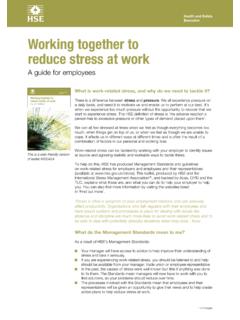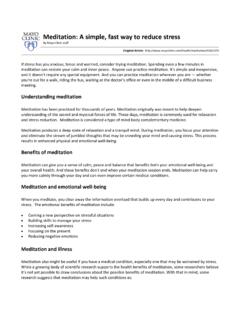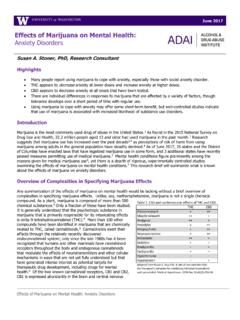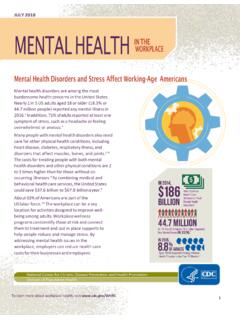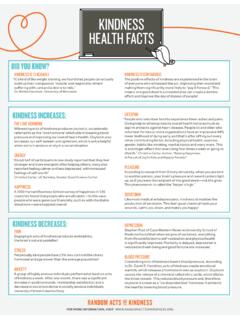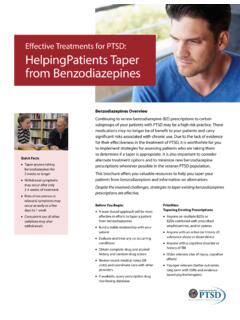Transcription of CAUSES AND MANAGEMENT OF STRESS AT WORK
1 CAUSES AND MANAGEMENT OFSTRESS AT WORKS MichieStress has been defined in different ways over the years. Originally, it was conceived of as pres-sure from the environment, then as strain within the person. The generally accepted defini-tion today is one of interaction between the situation and the individual. It is the psychologi-cal and physical state that results when the resources of the individual are not sufficient to copewith the demands and pressures of the situation. Thus, STRESS is more likely in some situations thanothers and in some individuals than others. STRESS can undermine the achievement of goals, bothfor individuals and for organisations (box 1).
2 Signs of STRESS can be seen in people s behaviour, especially in changes in responses to STRESS may be in the areas of feelings (for example, anxiety, depression, irri-tability, fatigue), behaviour (for example, being withdrawn, aggressive, tearful, unmotivated),thinking (for example, difficulties of concentration and problem solving) or physical symptoms (forexample, palpitations, nausea, headaches). If STRESS persists, there are changes in neuroendocrine,cardiovascular, autonomic and immunological functioning, leading to mental and physical illhealth (for example anxiety, depression, heart disease) (box 2, fig 1).
3 1 Situations that are likely to cause STRESS are those that are unpredictable or uncontrollable,uncertain, ambiguous or unfamiliar, or involving conflict, loss or performance expectations. Stressmay be caused by time limited events, such as the pressures of examinations or work deadlines, orby ongoing situations, such as family demands, job insecurity, or long commuting that help meet the pressures and demands faced at work include personal character-istics such as coping skills (for example, problem solving, assertiveness, time MANAGEMENT ) and thework situation such as a good working environment and social support.
4 These resources can beincreased by investment in work infrastructure, training, good MANAGEMENT and employmentpractices, and the way that work is , the typical response from employers to STRESS at work has been to blame the victimof STRESS , rather than its cause. Increasingly, it is being recognised that employers have a duty, inmany cases in law, to ensure that employees do not become ill. It is also in their long term economicinterests to prevent STRESS , as STRESS is likely to lead to high staff turnover, an increase in sicknessabsence and early retirement, increased STRESS in those staff still at work, reduced work perform-ance and increased rate of accidents, and reduced client employment practice includes assessing the risk of STRESS amongst employees.
5 Thisinvolves:clooking for pressures at work which could cause high and long lasting levels of stresscdeciding who might be harmed by thesecdeciding whether you are doing enough to prevent that STRESS IS CAUSEDThe degree of STRESS experienced depends on the functioning of two protective physiologicalmechanisms:c Alarm reaction . When confronted with a threat to our safety, our first response is physio-logical arousal: our muscles tense and breathing and heart rate become more rapid. Thisserves us well when the threat is the proverbial bull in the field rushing towards us. Weeither fight or flee. Present day threats tend to be more psychological for example, unjus-tified verbal attack by a superior at work.
6 It is usually not socially acceptable to act by fightor flight , and an alternative means of expressing the resultant emotional and physicalenergy is required. This falls in the arena of assertive Adaptation . The second adaptive mechanism allows us to cease responding when welearn that stimuli in the environment are no longer a threat to our safety. For example,when we first spend time in a house near a railway line, our response to trains hurtling pastis to be startled, as described above. Over time, our response dwindles. If this process did notfunction, we would eventually collapse from physical wear and tear, and Environ Med2002;59:67 72*67 Correspondence to:Dr Susan Michie, Royal Freeand University CollegeMedical School, Pond Street,London NW3 2QG, on January 31, 2022 by guest.
7 Protected by Environ Med: first published as on 1 January 2002. Downloaded from STRESS is experienced when either of these mechanisms are notfunctioning properly or when we find it difficult to switchappropriately from one to another. This forms the basis ofindividual approaches to STRESS MANAGEMENT (fig 2). Figure 2shows that it is the perception, or appraisal, of the situationthat is key to whether or not it CAUSES STRESS . This is the basisof the transactional model of STRESS ,2whereby the ability of aperson to prevent or reduce STRESS is determined by thatperson s appraisal of (a) the threat within a situation (primaryappraisal), and (b) the appraisal of his/her coping skills to dealwith that threat (secondary appraisal).
8 These appraisals havebeen shaped by past experiences of confronting STRESS and, inturn, influence future behaviour and appraisals. Thus, theprocess of appraisal, behaviour, and STRESS is continuous, andmanaging STRESS can result from changing the way the situa-tion is appraised (cognitive techniques) or responded to(behavioural or cognitive techniques).WORKPLACE FACTORS CAUSING STRESSThe workplace is an important source of both demands andpressures causing STRESS , and structural and social resources tocounteract workplace factors that have been found to be associatedwith STRESS and health risks can be categorised as those to dowith the content of work and those to do with the social andorganisational context of work (fig 1).
9 Those that are intrinsicto the job include long hours, work overload, time pressure,difficult or complex tasks, lack of breaks, lack of variety, andpoor physical work conditions (for example, space, tempera-ture, light).Box 1: The problem of stressFor the individualFor the workplace/organisationThreats to:+HealthIncreased absenteeism and turnover+Well being/quality of life Reduced quantity and quality of work+Functioning/goalachievementReduced job satisfaction and moraleProblems of recruitment+Self esteem/confidence Poor communication and increasedconflict+Personal developmentFigure 1A model of STRESS at of STRESS at workIndividual characteristicsSymptoms of occupational ill healthDiseaseIntrinsic to job:Poor physical working conditionsWork overloadTime pressuresPhysical danger, etcRole in organisation.
10 Role ambiguityRole conflictResponsibility for peopleConflicts re organisational boundaries(internal and external), etcCareer development:Over promotionUnder promotionLack of job securityThwarted ambition etcRelationship at work:Poor relations with boss, subordinates, or colleaguesDifficulties in delegating responsibility, etcOrganisational structure and climate:Little or no participation in decisionRestrictions on behaviour (budgets, etc)Office politicsLack of effective consultation, etcFinancial difficulties, etcThe individual:Level of anxietyLevel of neuroticismTolerance for ambiguityType A behaviouralpatternExtra-organisationalFa mily problemsLife crisesDiastolic blood pressureCholesterol concentrationHeart rateSmokingDepressive moodEscapist drinkingJob dissatisfactionReduced aspiration etcCoronaryheart diseaseMentalill healthBox 2.

